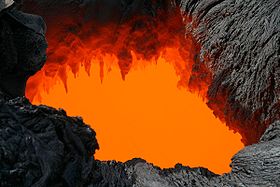
Lavacicle
Encyclopedia

Stalactite
A stalactite , "to drip", and meaning "that which drips") is a type of speleothem that hangs from the ceiling of limestone caves. It is a type of dripstone...
s that are found in lava tubes, the name comes from their resemblance to icicle
Icicle
An icicle is a spike of ice formed when water dripping or falling from an object freezes. Typically, icicles will form when ice or snow is melted by either sunlight or some other heat source , and the resulting melted water runs off into an area where the ambient temperature is below the freezing...
s.
Lavacicle is really a generic term that encompasses several different types of stalactites found in lava tubes, which differ in their shape and morphology (from Bunnell, 2008):
Shark Tooth Stalactites
The shark tooth stalactite is broad and tapering in appearance. It may begin as a small driblet of lava from a semi-solid ceiling, but then grows by accreting layers as successive flows of lava rise and fall in the lava tube, coating and recoating the stalactite with more material. They can vary from a few millimeters to over a meter in length.Splash Stalactites
As lava flows through a tube, material will be splashed up on the ceiling and ooze back down, hardening into a stalactite. This type of formation results in a very irregularly shaped stalactite, looking somewhat like stretched taffy. Often they may be of a different color than the original lava that formed the cave.Tubular lava stalactites
When the roof of a lava tube is cooling, a skin will form that traps semi-molten material inside. Trapped gases force lava to extrude out through small openings that result in hollow, tubular stalactites analogous to the soda straws formed as depositional speleothems in solution caves, The longest known is almost 2 meters in length. These are common in Hawaiian lava tubes and are often associated with a drip stalagmiteStalagmite
A stalagmite is a type of speleothem that rises from the floor of a limestone cave due to the dripping of mineralized solutions and the deposition of calcium carbonate. This stalagmite formation occurs only under certain pH conditions within the underground cavern. The corresponding formation on...
that forms below as material is carried through the tubular stalactite and piles up on the floor beneath. Sometimes the tubular form collapses near the distal end, most likely when the pressure of escaping gases decreased and still-molten portions of the stalactites deflated and cooled.
Often these tubular stalactites will acquire a twisted, vermiform appearance as bits of lava crystallize and force the flow in different directions. These tubular lava helictites may also be influenced by air currents through a tube and point downwind.
See also
- IcicleIcicleAn icicle is a spike of ice formed when water dripping or falling from an object freezes. Typically, icicles will form when ice or snow is melted by either sunlight or some other heat source , and the resulting melted water runs off into an area where the ambient temperature is below the freezing...
- Lava tubeLava tubeLava tubes are natural conduits through which lava travels beneath the surface of a lava flow, expelled by a volcano during an eruption. They can be actively draining lava from a source, or can be extinct, meaning the lava flow has ceased and the rock has cooled and left a long, cave-like...
- Soda strawSoda strawA soda straw is a speleothem in the form of a hollow mineral tube. They grow in places where water leaches slowly through cracks in rock, such as on the roofs of caves...
- Speleothems
- StalactiteStalactiteA stalactite , "to drip", and meaning "that which drips") is a type of speleothem that hangs from the ceiling of limestone caves. It is a type of dripstone...
- StalagmiteStalagmiteA stalagmite is a type of speleothem that rises from the floor of a limestone cave due to the dripping of mineralized solutions and the deposition of calcium carbonate. This stalagmite formation occurs only under certain pH conditions within the underground cavern. The corresponding formation on...
External links
- VULCON Guidebook: Some Volcanic, Cave and Karst terms Ken Grimes, Accessed 02 October 2007
- The Virtual Lava Tube Large educational site on lava tube features and how they form, with lots of photos

